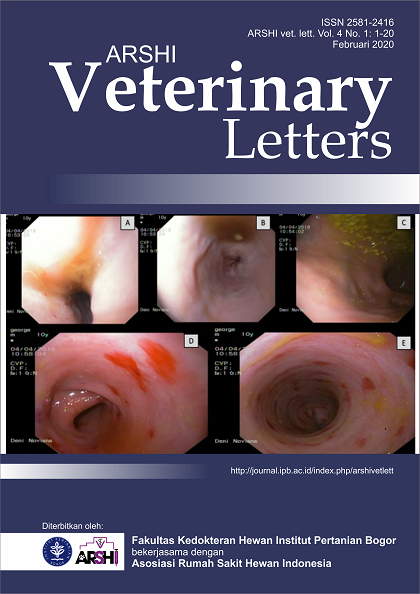Pathology of cutaneous blastomycosis in a cat
Abstract
Cats are common as pet animals in Indonesia and live in close vicinity of human neighborhood, which make them potential for transmitting diseases to human. Blastomycosis is infectious disease caused by Blastomyces spp yeast. Here we describe morphopathology of blastomycosis found in skin of a Persian Cat. Grossly, the lesion were characterized by ulcerated wounds and multiple subcutaneous small nodules (2-5 mm in diameter) in the base of tail. Skin biopsy was made and further processed for histopathology. Microscopically, the lesion consist of epidermal necrosis, dermatitis, with coalescing dermal granulomatous inflammation, characterized by epitheloid and foreign type giant cells infiltrates. Numerous spherical-shaped structures and pseudohyphae which are Periodic Acid Schiff (PAS)-positive consistent with yeast morphology were found within the granulomas; morphology is also consistent with Blastomyces spp yeasts. Conclusively, multiple granulomatous dermatitis with evidence of Blastomyces yeasts is a hallmark of cutaneous blastomycosis. Exposure to Blastomyces spp yeast may possess infection threat to pet owners.
Downloads
References
Barker A. 2018. Jakarta has a serious cat problem, containing it is dirty work. ABC News. https://www.abc.net.au/news/2018-03-19/inside-jakartas-battle-to-control-feral-cats/9541636
Duangkaew L, Larsuprom L, Kasondorkbua C, Chen C, Chindamporn A. 2017. Cutaneous blastomycosis and dermatophytic pseudomycetoma in a Persian cat from Bangkok, Thailand. Medical Mycology Case Reports. 15: 12-15.
Gross TL. Ihrke PJ, Walder EJ, Affolter VK. 2005. Skin diseases of a dog and cat. Blackwell Science.
Jankovsky JL, Donnell RL. 2014. Blastomyces dermatitidis pneumonia in a Ilama. Journal of Veterinary Diagnostic In-vestigation. 30(4): 576-579.
Copyright (c) 2020 CC-BY-SA

This work is licensed under a Creative Commons Attribution-ShareAlike 4.0 International License.
Authors who publish with this journal agree to the following terms:
1. Authors retain copyright and grant the journal right of first publication with the work simultaneously licensed under a Creative Commons Attribution License that allows others to share the work with an acknowledgement of the work's authorship and initial publication in this journal.
2. Authors are able to enter into separate, additional contractual arrangements for the non-exclusive distribution of the journal's published version of the work (e.g., post it to an institutional repository or publish it in a book), with an acknowledgement of its initial publication in this journal.
3. Authors are permitted and encouraged to post their work online (e.g., in institutional repositories or on their website) prior to and during the submission process, as it can lead to productive exchanges, as well as earlier and greater citation of published work (See The Effect of Open Access).


.jpg)















